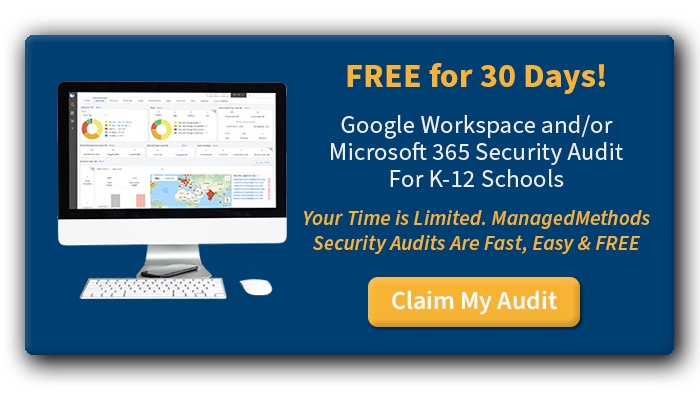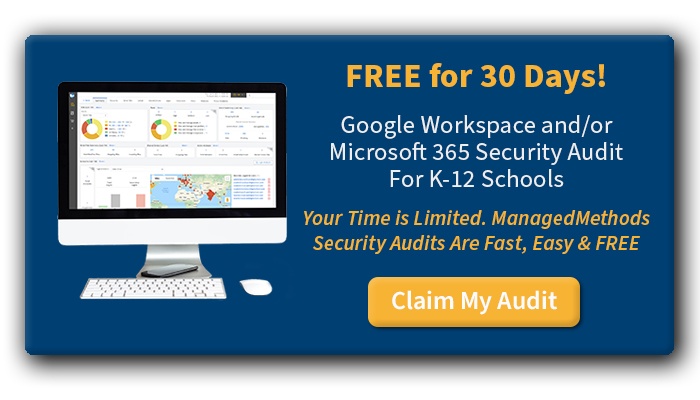
2024-6-13 19:5:38 Author: securityboulevard.com(查看原文) 阅读量:2 收藏
Information technology has done wonders for K-12, but it’s also ramped up cyber risk exponentially. According to Microsoft, cyber threats impact education more than any other industry, totaling 80% of all malware encounters in the past 30 days.
To put that into perspective, retail is the next most impacted industry. Yet, it only accounts for 9% of all incidents worldwide. Suffice to say, hackers are targeting schools at an unrelenting rate, and it’s only a matter of time before they come for your district.
But don’t worry, there’s plenty you can do to protect your sensitive data — the only question is, where do you start? Fortunately, that’s what an information security framework is all about.
In this guide, we’ll explain the value of cybersecurity frameworks and how they support your data protection strategy. Plus, we’ll give you eight examples and tips on choosing the best one for your district.
What is an information security framework?
An information or cybersecurity framework is a set of policies, procedures, and best practices for establishing and maintaining data security controls.
Like a blueprint, frameworks help organizations build a solid foundation to defend against cyber threats and improve risk management. With guidelines in place, this structured approach makes it easier for security teams to strategically and effectively protect sensitive information.
Think of a cybersecurity framework as a GPS. Not only does it tell you where to go, but it also explains how to get there one step at a time. Most importantly, it ensures your security posture doesn’t veer off course — or in other words, leave vulnerable gaps in your defenses.
Security frameworks vs. standards vs. regulations
Frameworks are closely related to security standards and regulations, but the three terms aren’t interchangeable. Let’s break down the differences:
- Cybersecurity frameworks provide flexible best practices you can adapt to your needs, helping mitigate cyber threats and enhance risk management.
- Security standards are typically industry-specific requirements that establish baseline security criteria. They’re generally voluntary guidelines you can follow to improve cyber risk management and data protection. Standards are often based on frameworks, and vice versa.
- Security regulations, such as data privacy laws, are legally enforceable rules, meaning compliance is mandatory. Oftentimes, regulations align with particular security standards or frameworks.
Although all three can help push your data security strategy in the right direction, frameworks are the most comprehensive of the bunch. Beyond standards and best practices, they also often include actionable steps, recommended tools, and a wider network of resources.
Why are cybersecurity frameworks important?
Given how vital information technology is in today’s landscape, it’s a good idea for any organization to implement a cybersecurity framework. That said, this step is especially important for K-12.
The truth is that despite being the most vulnerable sector, education is trailing behind other industries in terms of cybersecurity. According to the Cybersecurity and Infrastructure Security Agency (CISA), this is largely due to several factors:
- Insufficient resources
- Lack of expertise
- Outdated experience
- Low oversight and accountability
To top it off, the breadth of cyber threats is growing. Between 2016 and 2021, the number of reported incidents tripled. And, without a proper structure in place, addressing them is an uphill battle. That’s why CISA included cybersecurity frameworks as one of its top recommendations for K-12 districts.
In short, a security framework takes the guesswork out of data protection. It provides a standardized approach to cyber risk management, regardless of how big or small your district is. This not only makes compliance easier but also empowers you to protect sensitive information with tried and tested security controls.
Types of security frameworks
Cybersecurity frameworks fall into three categories, defined by their purpose and level of maturity:
- Control frameworks: A control framework helps you develop an initial security strategy and roadmap for improvement. With a baseline set of security controls, it acts as a starting place for your district to protect data and assess its technical capabilities.
- Program frameworks: A program framework takes a broader, top-down view of your data security strategy. The goal is to help you understand your overall security posture, evaluate maturity, simplify communication, and identify vulnerabilities.
- Risk management frameworks: A risk management framework is a hallmark of any mature cybersecurity program. It focuses on defining the necessary, actionable steps to understand, categorize, and manage cyber risk factors. It emphasizes the risk assessment process, which helps prioritize activities for better efficiency.
8 examples of information security frameworks
The world of cybersecurity is expansive, and populated with many different frameworks. Here are eight of the most popular:
1. ISO 27001 and 27002
Developed by the International Organization for Standardization (ISO), the ISO 27001 framework is considered the world’s best-known standard for information security management. It provides companies of all sizes and sectors with guidelines for establishing, implementing, maintaining, and improving an information security management system (ISMS).
Broadly, it applies to any organization that handles sensitive data. However, it’s an extremely comprehensive standard more suitable for enterprises than K-12 school districts.
2. General Data Protection Regulation
The General Data Protection Regulation (GDPR) is a landmark cybersecurity legislation in the European Union (EU). It impacts any business that collects or processes EU citizens’ data, whether the company is based in Europe or internationally.
GDPR has established a framework for consumer access control, data protection rights, consent, and more. However, given its specificity, this regulation’s guidelines are much less applicable to K-12 than to other sectors.
3. PCI DSS
The Payment Card Industry Data Security Standard, or PCI DSS, impacts any organization that accepts, processes, or stores credit card information. This security framework is specifically meant to keep cardholder data safe through strict access management controls.
Marking a difference from regulations, card networks like MasterCard and Visa are responsible for enforcing PCI DSS compliance. And, unless your district stores payment data, it’s probably not applicable to you.
4. NIST SP 800-53
The National Institute of Standards and Technology (NIST) published Special Publication 800-53 in 1990. It’s evolved over the intervening years and is now the bedrock of U.S. government data security.
In short, only federal agencies are required to comply with NIST SP 800-53, but any company can implement it. As a comprehensive framework, its guidelines are appropriate for virtually all security use cases.
5. COBIT
COBIT stands for Control Objectives for Information and Related Technology. Since the 90s, this framework has helped organizations reduce cyber risk by enabling them to implement information management systems.
The latest version, COBIT 2019, accounts for today’s more complex environment. However, despite its flexibility, it’s more appropriate for enterprise purposes than education.
6. CIS Critical Security Controls
Created by the Center for Internet Security (CIS), the CIS Critical Security Controls framework offers over 150 recommended practices organized into 18 categories and three implementation groups. More simply, it provides a prescriptive set of practices you can use to improve data protection.
Notably, one of its chief aims is to simplify cybersecurity, which makes it great for K-12 teams with limited professional experience. It emphasizes basic cyber hygiene, helping schools address the root causes of security incidents.
7. K12 SIX Essential Protections
Unlike most frameworks, which are broad by design, the K12 Security Information Exchange (SIX) created one specifically for the education sector. The K12 SIX Essential Protections framework provides a relevant, practical, and understandable set of guidelines aligning with insurance requirements and government guidance.
Also, it offers a rubric you can use to evaluate your cybersecurity posture. It’s based on four levels of implementation, so you can easily identify areas where you’re at risk or need improvement.
8. NIST CSF
The NIST Cybersecurity Framework is perhaps the most comprehensive and widely used around the world. Applicable to virtually all use cases, NIST CSF offers detailed guidance on five high-level functions:
- Identify
- Protect
- Detect
- Respond
- Recover
Overall, this framework provides a clear, flexible roadmap that’s easily tailored to a K-12 environment. It can also help you implement a zero trust security strategy. For more information on NIST CSF, check out our collection of resources and solutions.
Start your cybersecurity journey with ManagedMethods
You’ve seen eight examples of popular security frameworks, but which is best for your specific needs? Consider what’s most suitable for a K-12 environment. More likely than not, these three are your frontrunners:
- CIS Critical Security Controls
- K12 SIX Essential Protections
- NIST Cybersecurity Framework
Regardless of which one you pick, you’ll have to implement security controls and data protection to support it. That’s where ManagedMethods can help.
With Cloud Monitor patrolling your Google Workspace and Microsoft 365 domains and detecting cyber threats, you’ll have the visibility you need to leap into action. And, thanks to Content Filter, you won’t have to worry about students and staff accessing malicious websites or inappropriate content online. In combination, these solutions not only protect sensitive information but also the safety of your entire district.
Want to see these platforms in action? Kick-start your cybersecurity journey today by scheduling your free cybersecurity and safety audit with ManagedMethods.
The post Choosing An Information Security Framework: 8 Examples For K-12 appeared first on ManagedMethods.
*** This is a Security Bloggers Network syndicated blog from ManagedMethods authored by Alexa Sander. Read the original post at: https://managedmethods.com/blog/information-security-framework/
如有侵权请联系:admin#unsafe.sh
![[FREE] Google Workspace and/or Microsoft 365 Security Audit. Learn More & Claim >>](https://no-cache.hubspot.com/cta/default/6834707/25278544-250d-4265-b25f-0c160bf67707.png)
